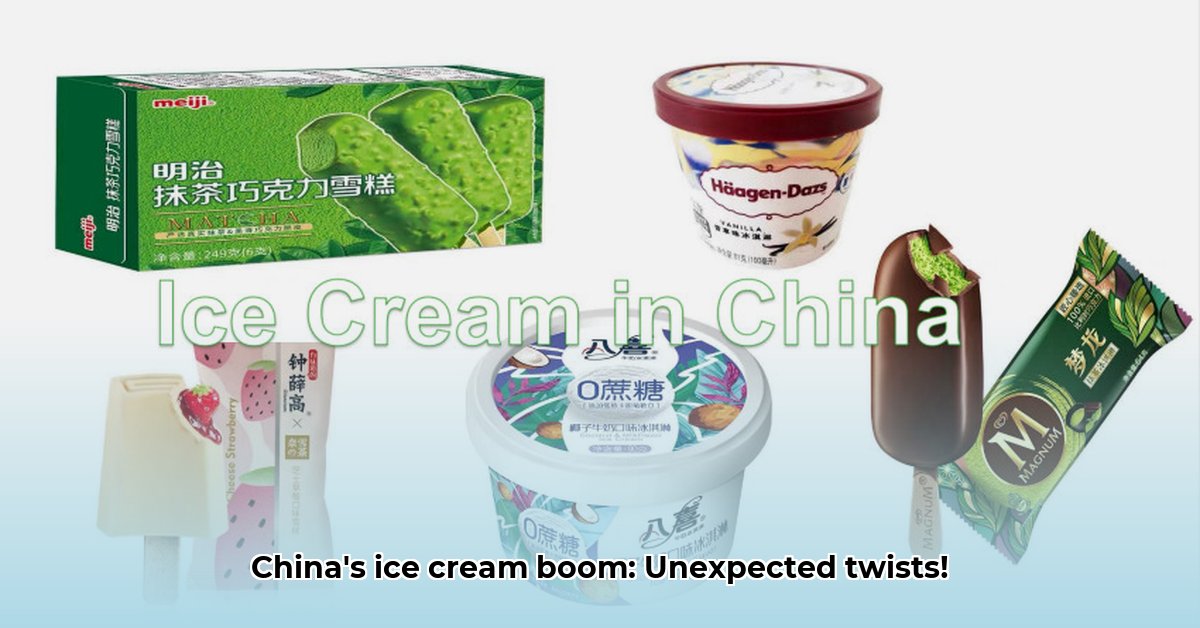Forget what you think you know about ice cream! In China, it’s a colossal, rapidly expanding market worth billions, fueled by increasing incomes, online shopping, and a quest for novel tastes. This article explores this dynamic scene, spotlighting key players, emerging trends, and actionable strategies for achieving success in this delectable domain.
Decoding the China Ice Cream Market: Growth Drivers and Future Trends
China’s ice cream market is experiencing exponential growth, valued at over RMB 160 billion in 2021 and projected to surpass RMB 275 billion by 2027 (USD 40.19 billion). This frozen phenomenon is attributed to several key factors: escalating disposable incomes, the dominance of e-commerce, and the ever-evolving preferences of Chinese consumers.
The Sweet Story Unfolds: Key Factors of the Ice Cream Boom
Several factors are converging to create this sweet success story. Foremost, rising disposable incomes empower a larger segment of the population to indulge in treats like ice cream more frequently. The surge in e-commerce, which accounted for 20% of ice cream sales in 2021, has been transformative. Livestream shopping is further amplifying this trend, fostering social demand and stimulating sales. Finally, consumer preferences are evolving, demanding unique flavors, visually stunning presentations, and healthier options.
- Rising Incomes: Greater purchasing power translates to increased spending on discretionary treats.
- E-commerce Boom: Online shopping and livestreaming platforms offer unprecedented access and convenience, significantly boosting sales.
- Evolving Tastes: Consumers are actively seeking innovative flavors, visually appealing products, and health-conscious choices.
The Big Players: Domestic vs. International Ice Cream Brands
The Chinese ice cream market is characterized by a mix of established domestic giants, such as Yili and Mengniu, boasting extensive distribution networks, and international brands vying for market share. International players can succeed by adapting to Chinese consumer preferences. This requires a profound understanding of their unique tastes and cultural nuances. Brands like Häagen-Dazs have found success by positioning themselves as premium options. Russian brands, like Kopobka, are attracting consumers with healthier options.
Trends Shaping the Future of Frozen Delights
The Chinese ice cream market is in constant flux, with trends emerging and evolving at a rapid pace. The “Guochao” movement, which celebrates Chinese aesthetics and cultural heritage, is exerting a significant influence on branding and product design. Beyond cultural influences, there is a constant drive for flavor innovation, with novel combinations such as baijiu (traditional Chinese liquor) infused ice cream capturing consumer attention. The growing awareness of health and wellness is also fueling demand for low-sugar, low-fat, and additive-free options. Furthermore, “Instagrammable” ice cream, characterized by elaborate designs and visually striking presentations, is proving to be a powerful driver of sales, particularly among younger consumers.
Opportunities and Challenges in the Chinese Ice Cream Market: A Balancing Act
The Chinese ice cream market presents both lucrative opportunities and significant challenges for both international and domestic players. To navigate this complex landscape effectively, companies must adopt tailored strategies that address the specific nuances of the market.
For International Brands:
- Short-Term (0-1 Year): Adapt to local tastes by introducing Chinese-inspired flavors, master e-commerce marketing techniques specific to Chinese platforms, and collaborate with local influencers to build brand awareness.
- Long-Term (3-5 Years): Establish local R&D facilities to develop products tailored to Chinese preferences, invest in building a robust distribution network, and strategically align with the “Guochao” movement to resonate with consumers’ cultural identity.
For Domestic Brands:
- Short-Term (0-1 Year): Focus on continuous flavor and packaging innovation to stay ahead of the competition, strengthen online presence through targeted marketing campaigns, and expand distribution channels to reach a wider consumer base.
- Long-Term (3-5 Years): Invest in developing premium product lines to capitalize on the growing demand for high-quality ice cream, explore opportunities for international expansion to diversify revenue streams, and integrate sustainable practices into operations to appeal to environmentally conscious consumers.
“Adapting to the unique local tastes and preferences of Chinese consumers is absolutely critical for international brands aiming to establish a strong foothold and achieve sustainable success in this dynamic market,” said [Xiaohua Wang, Senior Market Analyst], [Euromonitor International].
Navigating Potential Ice Cream Market Risks: A Realistic Outlook
The ice cream industry, like any other, is subject to a range of inherent risks and challenges. Potential challenges include intensifying domestic competition, shifting consumer preferences, evolving regulatory landscape, and the potential for supply chain disruptions.
| Risk Factor | Likelihood | Impact | Mitigation |
|---|---|---|---|
| Intense Domestic Competition | High | High | Differentiate products through unique flavors, innovative packaging, and strong branding; implement targeted marketing campaigns to build brand loyalty; optimize supply chain to reduce costs and improve efficiency. |
| Changing Consumer Preferences | Medium | Medium | Conduct continuous market research to monitor evolving consumer trends; adapt product offerings to meet changing demands; foster a culture of innovation within the organization to anticipate future trends. |
| Regulatory Changes | Low | High | Maintain close relationships with regulatory bodies; stay informed about upcoming changes to food safety regulations; implement robust quality control measures to ensure compliance. |
| Supply Chain Disruptions | Medium | Medium | Diversify sourcing of ingredients and packaging materials; build strong relationships with multiple suppliers; implement inventory management strategies to mitigate the impact of potential disruptions. |
A Frosty Future: Predicting What Lies Ahead
The future of China’s ice cream market appears promising. As consumer preferences continue to evolve and technological advancements reshape the industry, the market is poised for continued growth and innovation. Companies that demonstrate agility, embrace innovation, and possess a deep understanding of the local market will be best positioned to thrive in this dynamic environment.
Crafting a Road Map: How to Launch a Successful International Ice Cream Brand in China
Key Takeaways:
- The premium ice cream segment in China is experiencing substantial growth, surpassing US consumption in some categories.
- Rising incomes and evolving consumer taste preferences are the primary drivers of this growth. Delivering unique and memorable brand experiences is crucial for success.
- Digital marketing is paramount, with brands leveraging Key Opinion Leaders (KOLs) and various social media platforms to reach target audiences.
The Frosty Frontier: Navigating China’s Delicious Ice Cream Market
China’s ice cream market is undergoing a period of rapid expansion, fueled by rising disposable incomes, sophisticated marketing strategies, and evolving consumer preferences. Consumers increasingly demand more than just traditional flavors; they seek unique and exciting culinary experiences.
- China’s premium ice cream market is experiencing a boom, exceeding the US in consumption volume in certain segments.
- Consumers are actively seeking unique and exciting flavor experiences that push the boundaries of traditional ice cream.
- Strategic digital marketing through online channels is essential for connecting with consumers and building brand awareness.
Cracking the Flavor Code: Consumer Tastes and Visual Appeal
Consumers, particularly within the premium segment, are drawn to unique and unconventional flavors, such as spicy chocolate, salted egg yolk, and even squid ink, demonstrating a willingness to experiment with bold and unexpected taste combinations. Beyond flavor, visual appeal plays a critical role, with Instagram-worthy creations becoming a must-have for brands seeking to capture attention on social media. There is also an increasing demand for healthier options, reflecting a growing focus on health and wellness among Chinese consumers.
The Digital Marketing Dilemma: Essential Strategies That Work
For international ice cream brands seeking to launch successfully in China, proficiency in digital marketing is non-negotiable. Collaborating with Key Opinion Leaders (KOLs) who wield significant influence over consumer purchasing decisions is crucial. Capitalizing on the “selfie” trend by creating visually appealing ice cream products that are both delicious and highly shareable on social media platforms can generate significant brand awareness and drive sales.
“A comprehensive understanding of the Chinese digital landscape, including the nuances of various social media platforms and the power of KOLs, is absolutely crucial for any brand seeking to effectively reach and engage its target audience in this market,” said [Mei Li, Marketing Director], [Alibaba Marketing Solutions].
Managing the Challenges: Distribution and Pricing
Maintaining a consistent -26°C cold chain across China’s vast and geographically diverse landscape poses a significant logistical hurdle, impacting both cost and product quality. While a premium positioning often equates to luxury and exclusivity, it can also be perceived as excessively expensive by some consumers, requiring careful consideration of pricing strategies.
Actionable Steps to Dominate the Chinese Ice Cream Market
Here’s a roadmap for launching a successful international ice cream brand in China:
- Market Research: Conduct thorough market research to identify regional taste preferences, consumer demographics, and competitive landscape.
- Product Development: Develop innovative and healthy ice cream products that cater to local tastes and align with current health trends.
- Cold Chain: Invest in a reliable and efficient nationwide cold chain infrastructure to ensure product quality and integrity.
- Digital Marketing: Execute targeted digital marketing campaigns that leverage KOLs, social media platforms, and e-commerce channels to reach target consumers.
- Pricing: Carefully balance premium positioning with affordability to ensure accessibility to a wider consumer base.
- Strategic Partnerships: Collaborate with local businesses, retailers, and distributors to

















1 thought on “China Ice Cream Market: Explosive Growth & Trends”
Comments are closed.